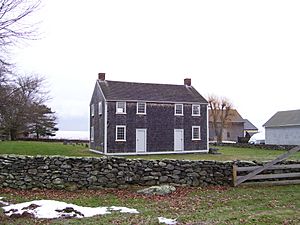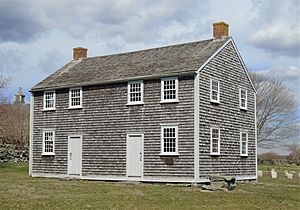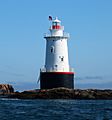Little Compton, Rhode Island facts for kids
Quick facts for kids
Little Compton, Rhode Island
|
|
|---|---|
|
Town
|
|
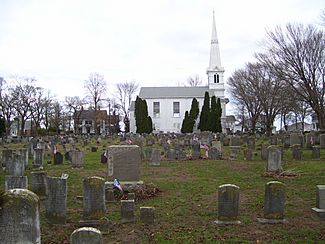
Town Common and the United Congregational Church
|
|
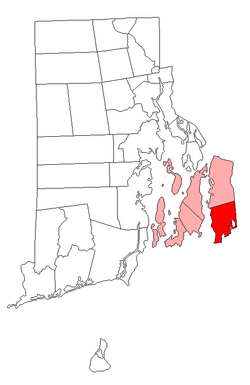
Location of Little Compton in Newport County, Rhode Island
|
|
| Country | United States |
| State | Rhode Island |
| County | Newport |
| Settled | 1675 |
| Incorporated | June 6, 1682 |
| Annexed by Rhode Island | January 27, 1747 |
| Government | |
| • Type | Town Council-Town Administrator |
| Area | |
| • Total | 28.9 sq mi (74.9 km2) |
| • Land | 20.9 sq mi (54.1 km2) |
| • Water | 8.0 sq mi (20.8 km2) |
| Elevation | 104 ft (25 m) |
| Population
(2020)
|
|
| • Total | 3,616 |
| • Density | 173/sq mi (66.8/km2) |
| Time zone | UTC–5 (Eastern) |
| • Summer (DST) | UTC–4 (Eastern) |
| ZIP Code |
02837
|
| Area code(s) | 401 |
| FIPS code | 44-42400 |
| GNIS feature ID | 1220062 |
Little Compton is a coastal town in Newport County, Rhode Island, bounded on the south by the Atlantic Ocean, on the west by the Sakonnet River, on the north by the town of Tiverton, and on the east by the town of Westport, Massachusetts. The population was 3,616 at the 2020 census.
Contents
History
According to 17th century land evidence, the area now known as Little Compton was originally inhabited by the Sakonnet (variations include Sogkonate, Seconit, Seaconnet, etc.) tribe, who were led by Awashonks. Awashonks' people lived in Wilbour Woods in the wintertime and at Sakonnet Point in the summertime. Her step-son Mamannuah led a separate Sakonnet tribe in the Adamsville area. The two leaders had frequent disputes over land and vied with each other to be recognized by the English as the sole Sakonnet leader.
Sakonnet has been interpreted in a variety of ways: "the black goose comes" or "where the water pours fourth."
The first European settlers in Little Compton were Englishmen from Duxbury, Massachusetts in the Plymouth Colony who sought to expand their land holdings. After first attempting negotiations with Awashonks, they petitioned the Plymouth Colony, which granted them their charter. In a series of lotteries beginning in 1674 and ending in the early 1680s, they divided the land in Little Compton into lots of standard sizes and began settling there. Among these 32 original proprietors was Colonel Benjamin Church. Church was well known for his role in the late 17th-century conflicts with surrounding Native American tribes, notably the Narragansetts and Wampanoags. In 1675, Church built his homestead in Little Compton, just prior to King Philip's War. Today, a plaque on the side of West Main Road gives the location of his original homestead. The plaque is located near house number 600 on the eastern side of West Main Road.
In 1682, Sakonnet was incorporated by the Plymouth Colony and renamed Little Compton. This is possibly a reference to Little Compton in Warwickshire, England. However, there is no direct evidence to substantiate this relationship. By 1747, Little Compton secured its own royal decree and was annexed to Newport County as a part of Rhode Island along with Tiverton and Bristol. Because Little Compton was once part of the Plymouth colony, all probate and land records prior to 1746 can be found in Taunton and New Bedford.
Sites of historic interest in Little Compton include the Wilbor House, built in 1692 by Samuel Wilbore, now the home of the Little Compton Historical Society. The entire town commons is also on the National Register of Historic Places.
There are about 57 historic cemeteries in the town. Colonel Benjamin Church and his family are buried in the Little Compton Commons cemetery, as is Elizabeth Pabodie, the eldest daughter of John Alden and Priscilla Mullins of Mayflower fame. The stones in the cemetery reflect a style of carving similar to that found both in Newport and in Boston during the same time period.
Little Compton is the location for one of three town commons in Rhode Island. The others are in Warren and Bristol. This is most likely a result of the town having been originally laid out by settlers from the Plymouth and Massachusetts Colonies. Land for the common was designated in August 1677 and has been used ever since as both a religious and civic center for social activities in the town.
While there are only a few 17th-century structures still standing (these include the Wilbor house and Peabody house), there are many which date from the 18th and 19th century. The Quaker meeting house on West Main Road, Number 8 Schoolhouse (now used as part of the Town Hall), Town Hall, Wilbur's Store, and the United Congregational Church all pre-date 1900 and are centered around the town commons. Additional historic homes are scattered throughout the town and include the Asa Gray house, the Slicer house, Oldacre, the Brownell house on West Main Road, the Brownell house on Meetinghouse Lane, William Whalley Homestead farmstead on Burchard Ave. (on the National Register of Historic Places), and the Brownell Library on the commons.
Another distinctive feature of the town is the "Spite Tower" found in the village of Adamsville. Local lore claims that the tower was constructed to obscure the line of sight of a town local. While most stories involve members of the local Manchester family, there is no consensus as to the true history of the structure. According to the present day owner of the building, the "Spite Tower" was built above an artesian well. There was a pump that brought the water to a holding tank on the third floor that sent water, via gravity feed, to main house's water tank to provide running water. The building was constructed circa 1905. The chauffeur's residence was on the second floor of the tower.
During World War II Fort Church, named for Colonel Benjamin Church, was built with four batteries near Sakonnet Point. The largest was Battery Gray with two 16-inch guns, an area that would later become the Sakonnet Golf Club.
Demographics
| Historical population | |||
|---|---|---|---|
| Census | Pop. | %± | |
| 1790 | 1,542 | — | |
| 1800 | 1,577 | 2.3% | |
| 1810 | 1,553 | −1.5% | |
| 1820 | 1,580 | 1.7% | |
| 1830 | 1,378 | −12.8% | |
| 1840 | 1,327 | −3.7% | |
| 1850 | 1,462 | 10.2% | |
| 1860 | 1,304 | −10.8% | |
| 1870 | 1,166 | −10.6% | |
| 1880 | 1,202 | 3.1% | |
| 1890 | 1,128 | −6.2% | |
| 1900 | 1,132 | 0.4% | |
| 1910 | 1,273 | 12.5% | |
| 1920 | 1,389 | 9.1% | |
| 1930 | 1,382 | −0.5% | |
| 1940 | 1,492 | 8.0% | |
| 1950 | 1,556 | 4.3% | |
| 1960 | 1,702 | 9.4% | |
| 1970 | 2,385 | 40.1% | |
| 1980 | 3,085 | 29.4% | |
| 1990 | 3,339 | 8.2% | |
| 2000 | 3,593 | 7.6% | |
| 2010 | 3,492 | −2.8% | |
| 2020 | 3,616 | 3.6% | |
| U.S. Decennial Census | |||
In 2020, there were 3,616 people in 1,561 households. Of the 2,435 housing units in Little Compton in 2019, only 64% were reported as occupied, leaving 876 units (one-third) vacant for seasonal use only.
The population density of Little Compton was 170 people per square mile, which classifies as rural. In 2019, 94% of residents were White, 2% were Hispanic or Latino, 3% identified as multiracial (parents or ancestry from two or more races). More than half (53%) had earned a bachelor's degree or higher, which was 1.5 times greater than the rate of Rhode Island (34%). The median age in town was 57.8 years, considerably older than Rhode Island as a whole (39.9 years). The largest plurality of people (almost one-quarter of the town) was between the ages of 60–69. About 36% of the population was single. Only 2% of the town's population was under 10 years of age, far below the statewide average of 10%, and only 2% of women of childbearing age (ages 15–50) gave birth in 2019, a rate 60% lower than Rhode Island as a whole.
In 2021, the median value of owner occupied units was $747,500, more than double the value in Rhode Island as a whole ($319,000). A household needed an annual income of $165,309 to afford a median priced home in Little Compton, placing the town among the three most expensive zip codes in Rhode Island, ranking third most expensive behind only Block Island (New Shoreham) and East Providence.
As of 2019, the median household income in Little Compton was $89,353, which was 1.3 times higher than Rhode Island ($67,167). The per capita income in Little Compton was $60,000, or nearly 1.7 times higher than Rhode Island ($36,121). Of Little Compton's households, 440 (or 28%) were classified as cost-burdened for having to spend more than 30% of their income on housing costs. About 4.8% of the population lived below the poverty line, which was less than half the rate of Rhode Island (12.4%).
Rhode Island State Law 45-5356 establishes a goal that 10 percent of every city or town’s housing stock qualify as Low- and Moderate-Income Housing. In 2020, only 0.56% of Little Compton's housing stock qualified as meeting that goal, the lowest of any municipality in Rhode Island, leaving Little Compton as the most unaffordable town in Rhode Island and 153 units shy of the state target of 10%.
Geography
According to the United States Census Bureau, the town has a total area of 28.9 square miles (75 km2), of which, 20.9 square miles (54 km2) is land and 8.0 square miles (21 km2) (27.79%) is water. One of the largest bodies of water in Little Compton is Quicksand Pond.
Rhode Island Red
The Rhode Island Red is a breed of chicken originally bred in Adamsville, a small village that is part of Little Compton. Little Compton is the only place in the United States with a monument dedicated to a chicken. In 1925, the Rhode Island Red Club of America donated funds for an elegant monument to the Rhode Island Red in Adamsville, near the baseball field and across the street from the Barn restaurant. The monument is now on the National Register of Historic Places. A competing monument to the Rhode Island Red was erected by the state in 1954, 1-mile (1.6 km) south of Adamsville. Some claim that it was not created for the poultry fanciers, but for the farmers who raised them commercially in great numbers in Little Compton.
Attractions and sites on National Register of Historic Places
- Wilbor House Museum (1692)
- Friends Meeting House and Cemetery (1815)
- Little Compton Common Historic District
- Rhode Island Red Monument (1925)
- Sakonnet Light Station (1884)
- Stone House Inn (1854)
- William Whalley Homestead
- Little Compton Community Center
Education
There is one school in Little Compton, the Wilbur and McMahon School on School House Lane near the Common, originally known as the Josephine Wilbur (or Central) School; residents simply refer to it as "Wilbur School." It had 12 classrooms and housed the town's K–12 facilities. It was renamed after additions were built in the mid 1900s. Approximately 350 students attend classes in Kindergarten through 8th grade. High school students usually attend Portsmouth High School in Portsmouth, Rhode Island, about a 25 minute drive away.
Notable people
- Awashonks (c. 1620–c. 1684), female sachem (chief) of the Sakonnet tribe
- Jack Brennan (born 1937), president Richard Nixon's post-resignation chief of staff; has a summer home in Little Compton
- Sydney Richmond Burleigh (1853–1931), painter and illustrator; building and furniture designer; born in Little Compton
- J. C. Chandor (born 1974), writer, director, and Academy Award nominee for the screenplay of Margin Call; summer resident of Little Compton
- Colonel Benjamin Church (c. 1639–1718), founder of Little Compton. Known as the father of the United States Army Rangers and commander of Colonial forces during King Philip's War (1675–1676); died and is buried in Little Compton
- Isaiah Davenport (1784–1827), master builder
- Sylvester Graham, pastor, early vegetarian, namesake of the Graham Cracker
- Christopher R. Hill (born 1952), former Assistant Secretary of State for East Asian and Pacific Affairs and former United States Ambassador to Iraq; lived in Little Compton
- Henry Demarest Lloyd (1847–1903), political activist and muckraking journalist; lived in Little Compton
- J. William Middendorf (born 1924), United States Ambassador to the Netherlands, Permanent Representative to the Organization of American States, Secretary of the Navy, composer, and artist; lives in Little Compton
- Arden Myrin (born 1973), comedian and actress (MADtv, Chelsea Lately); born in Little Compton
- Elizabeth Pabodie (1623–1717), daughter of Plymouth Colony settlers John Alden and Priscilla Mullins, recognized as the first white girl born in New England; buried in Little Compton
- Abel Head "Shanghai" Pierce (1834–1900), a Texas rancher and cattleman; known as an authority on cattle; born in Little Compton
- Jacob Frank Schulman (1927–2006), Unitarian Universalist minister, theologian, and author of several books. Summer resident with wife Alice Southworth Schulman, descendant of John Alden, Priscilla Mullins and Constant Southworth, one of the original 16th century settlers
- John Simmons (1796–1870), clothing manufacturer; founder of Simmons College; born in Little Compton
- Henry Tillinghast Sisson (1831–1910), American Civil War era colonel in the Union Army; Lieutenant Governor of Rhode Island; inventor of the three-ring binder; lived and died in Little Compton
- Paul Suttell (born 1949), current Chief Justice of the Rhode Island Supreme Court; lives in Little Compton
- Charles Edwin Wilbour (1833–1896), journalist and Egyptologist who produced the first English translation of Les Misérables; born in Little Compton
- Isaac Wilbour (1763–1837), 6th Governor of Rhode Island; US congressman; 34th Chief Justice of the Rhode Island Supreme Court; born and died in Little Compton
- Rupert von Trapp (1911–1992), eldest son of the Trapp Family Singers, whose family story inspired The Sound of Music; lived in Little Compton
Images for kids
-
The Sakonnet Light Station was built in 1885 and renovated in 2012. It sits on a rock in the Sakonnet River off of Sakonnet Point
-
The "Spite Tower" in Adamsville, a hamlet of Little Compton, is a water tower which is purported to have been built out of spite.
See also
 In Spanish: Little Compton (Rhode Island) para niños
In Spanish: Little Compton (Rhode Island) para niños




